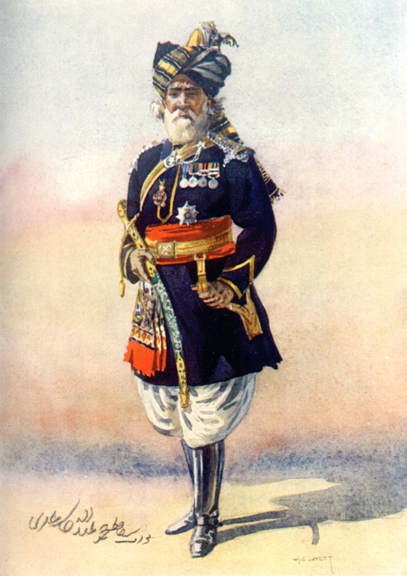Charles Cureton (1826–1891) on:
[Wikipedia]
[Google]
[Amazon]
Sir Charles Cureton (25 November 1826 – 11 July 1891) was a
 Cureton served in the
Cureton served in the
British Indian Army
The British Indian Army, commonly referred to as the Indian Army, was the main military of the British Raj before its dissolution in 1947. It was responsible for the defence of the British Indian Empire, including the princely states, which co ...
officer. He distinguished himself as a cavalry leader, and was recognised for acts of personal bravery. He became brevet colonel 14 February 1868, lieutenant-colonel 22 February 1869, major-general 22 February 1870, lieutenant-general 1 October 1877, and general 1 December 1888.
Life
He was a son ofCharles Robert Cureton
Brigadier-General Charles Robert Cureton (21 October 1789 – 23 November 1848) was a British Army officer who served as Adjutant-General in India.
Cureton was born at Union Street in Southwark, London,''London, England, Freedom of the City A ...
, and brother of Edward Burgoyne Cureton
Edward is an English given name. It is derived from the Anglo-Saxon name ''Ēadweard'', composed of the elements '' ēad'' "wealth, fortune; prosperous" and '' weard'' "guardian, protector”.
History
The name Edward was very popular in Anglo-Sax ...
(1822–1894), born in 1826. He received a commission as ensign in the East India Company's Bengal Army
The Bengal Army was the army of the Bengal Presidency, one of the three presidencies of British India within the British Empire.
The presidency armies, like the presidencies themselves, belonged to the East India Company (EIC) until the Govern ...
on 22 February 1843.
Having arrived in India on 24 June 1843, Cureton was appointed adjutant of the 12th regiment of irregular cavalry on 14 January 1846. He served in the First Anglo-Sikh War, and was present at the battle of Aliwal on 28 January 1846, receiving the medal and clasp. In the Second Anglo-Sikh War he was aide-de-camp to his father until the latter's death at the battle of Ramnagar, on 22 November 1848, where he was himself slightly wounded. He took part in the passage of the Chenab River on 2 and 3 December, in the battle of Gujrat, 21 February 1849, and in the pursuit, under Sir Walter Gilbert, of the Sikh army, the capture of Attock, and the occupation of Peshawar, receiving the medal and clasp.
 Cureton served in the
Cureton served in the north-west frontier campaigns
The North-West Frontier (present-day Khyber Pakhtunkhwa) was a region of the British Indian Empire. It remains the western frontier of present-day Pakistan, extending from the Pamir Knot in the north to the Koh-i-Malik Siah in the west, and separ ...
of 1849 to 1852, including the operations against the Baizai (1849)
The British Baizai district is a bay about 20 miles long and 12 miles broad, which runs into the hills between the Paja and Malakand ranges at the extreme N.W. of the Yusufzai division of the Peshawur district. It is inhabited by Baizai, Swati, ...
, and the Mohmand Expeditions (1851–2)
The Mohmand Expeditions were two British-Indian military expeditions to the North-West Frontier Province in Pakistan.
References
Military expeditions
History of Pakistan
Mohmand campaigns
{{Pakistan-stub ...
, receiving the medal and clasp. On 4 May 1852, he was appointed second in command of the 2nd irregular cavalry. He took part in the suppression of the Sonthal rebellion in 1856, and in the Indian Rebellion of 1857. He served against the Sealkote mutineers and took part in the action of Trimu Ghat, also against the Gogaira rebels. He raised and commanded Cureton's Multani cavalry
The 15th Lancers (''Cureton's Multanis'') was a cavalry regiment of the British Indian Army which existed from 1858 to 1921. Raised during the 1857 uprising, the regiment later saw service in the Second Afghan War of 1878–80 and the First Wo ...
, and continued to command it after it became the 15th Bengal cavalry. He served with it, and had charge of the intelligence department throughout the campaigns in Rohilkhand and Oude in 1858 and 1859, and was present at the actions of Bhagwala, Najina, Bareli, Shahjehanpur, Banai, Shahabad, Bankegaon, Mahodipur, Rasalpur, Mitaoli, and Biswa. He was 11 times mentioned in despatches published in general orders and received the medal and brevets of major and lieutenant-colonel. He served in the north-west frontier campaign of 1860, and on 2 June 1869 was made a Companion of the Order of the Bath
Companion may refer to:
Relationships Currently
* Any of several interpersonal relationships such as friend or acquaintance
* A domestic partner, akin to a spouse
* Sober companion, an addiction treatment coach
* Companion (caregiving), a caregive ...
(CB), military division.
For five years, from 22 October 1879, Cureton commanded the Awadh division of the Bengal Army. He was promoted to be Knight Commander of the Order of the Bath (KCB), military division, in May 1891. He died in England, at Eastbourne, Sussex, on 11 July 1891.
Family
Cureton married in 1852 Margaret Sophia Holmes, daughter of the Rev.William Anthony Holmes
William Anthony Holmes, D.D. (1782–1843) was a Church of Ireland cleric, chancellor of Cashel from 1832 and rector of Templemore, in the same diocese.
Life
The son of Joseph Holmes, he was born in Drogheda, County Louth. He entered Trinity Coll ...
. They had three sons, two of whom became army officers.
References
External links
;Attribution {{DEFAULTSORT:Cureton, Charles 1826 births 1891 deaths British Indian Army generals Companions of the Order of the Bath Knights Commander of the Order of the Bath